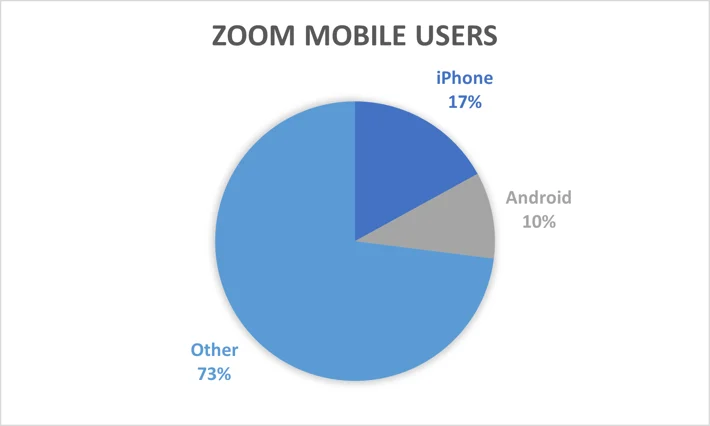Enterprises often manage their mobility expenses, including devices and calling plans, separately from more traditional telecom expenses such as fixed line assets, carrier contracts, desktop handsets and other hardware. This siloed view worked when the areas had little crossover in usage. But that discrete approach to conventional telephony and mobility management doesn’t work anymore. Instead, forward-looking businesses need to reshape their device lifecycle management strategy and take a fresh look at their organization’s relationship between SaaS and mobility management.
SaaS has become a mobility powerhouse
With the advent of SaaS, the two formerly distinct spheres of old-school telephony and mobile device management began to converge. And as employees and customers made the sudden and wide-ranging shift to remote work arrangements a few years ago, the convergence accelerated.
- In-person meetings now occur digitally, using UCaaS services such as Zoom, Teams or RingCentral.
- Standalone videoconferencing systems are being augmented (and sometimes replaced) with SaaS apps delivered as native mobility apps.
- Traditional desktop phones can now leverage software clients to access SaaS-based collaboration and communication services.
- Over 25% of UCaaS meetings are hosted and/or attended via a smart phone with iPhone leading the market by usage.
Other SaaS products are also integrating into the mobility space. It’s not uncommon for a team member—even those with easy access to a desktop computer—to pull up a Salesforce report on their iPhone or Android device using the Salesforce app. Workers find this method more convenient, and they’ve discovered that mobile apps often perform better than their desktop counterparts. Everything from menu navigation to functionality to speed are carefully tailored to the device, its screen real estate and its hardware capabilities. The result is less friction and faster performance. Going through a native app is often a much better user experience.
SaaS expansion clouds the expense management picture
Controlling and optimizing spend is far more challenging now that the SaaS and mobility management spheres are so heavily intertwined.
Few users understand the perimeters of the XaaS (Everything as a Service – SaaS, UCaaS, IaaS, PaaS etc.) various technologies—even seasoned IT professionals can find it difficult to draw clear demarcation lines between services. A desk phone that routes calls through a UCaaS provider enables functionality that happens under the radar and is rarely obvious to the user. Similar overlaps abound on the mobile device management side. The rise of UCaaS, including Zoom and Teams clients, has made mobile devices a popular landing spot for group discussions, presentations and data sharing.
With so much SaaS consumption happening through endpoint devices, enterprises struggle to identify where expenses originate and what they’re truly paying. Most have a good handle on the total cost of ownership for mobile devices, but what they’re not thinking about are all the other things happening behind the scenes and the usage that goes unnoticed. Lifecycle device management efforts are further complicated by the fact that some services can be delivered in multiple ways. Take Teams, for instance. It can be delivered as UCaaS and also as pure SaaS, with different modes of communication and potentially different kinds of devices available to users depending on their needs and preferences.

Discovery in device lifecycle management comes front and center
Because end users’ SaaS consumption can be obscured behind other capabilities and areas of spend, the ability to uncover, assess and optimize all those expenses is now a critically important part of a comprehensive device lifecycle management strategy.
Users might be on their smartphones, accessing SaaS apps via a laptop, or consuming services through a desktop phone. The right tools enable you to discover users that have signed into SaaS apps, pulling out data such as app-level integrations and other elements. Additional insights are available with targeted expense management technologies, such as who’s using the iOS version of a SaaS app, how many users leverage that app within that particular OS, and how frequently they access it.
With this information, your business gains important visibility into SaaS consumption on mobile endpoints. You can also apply those insights to forecast future spend and develop ways to optimize your enterprise’s use of SaaS apps.
- Are most sales team members using Salesforce on their mobile device?
- 36% of our revenue team accesses Salesforce on their mobile phone
- When that team travels, do you expect them to use the app more or less?
- Do you have traveling employees who don’t use the mobile app, but perhaps they’d be more efficient if they did?

Your discovery process may reveal that some corporate phones aren’t part of the organization’s chargeback program, leaving spend both unallocated and unmanaged. Deep SaaS data empowers you to ask these broad questions and to implement more effective cost control measures.
What it all means for enterprises
Connecting SaaS services and subscriptions with the devices used to access and consume them is the only way to understand the total cost of ownership and gain the total expense visibility that so many enterprises miss today. SaaS is no longer just what you see in web browsers—it has become everything that’s attached to the experience. It’s the when, the where, and the what (device) you consume them with. It’s time to elevate your expense management capabilities to keep pace with the rapid diffusion of SaaS services into the mobility space.
*Data from a 5,000 UCaaS user enterprise



